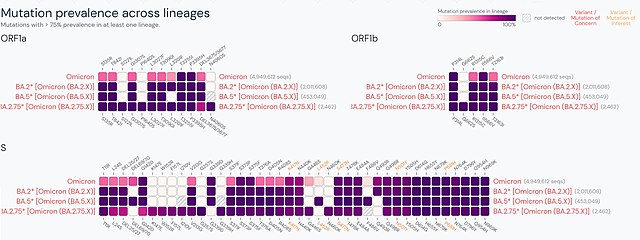Variants of severe acute respiratory syndrome coronavirus 2 (SARS-CoV-2) are viruses that, while similar to the original, have genetic changes that are of enough significance to lead virologists to label them separately. SARS-CoV-2 is the virus that causes coronavirus disease 2019 (COVID-19). Some have been stated, to be of particular importance due to their potential for increased transmissibility, increased virulence, or reduced effectiveness of vaccines against them. These variants contribute to the continuation of the COVID-19 pandemic.
Various SARS-CoV-2 variants that were reported officially by CDC, NIH, in May 2021 in relation to mutations L452R and E484K
False-colour transmission electron micrograph of a B.1.1.7 variant coronavirus. The variant's increased transmissibility is believed to be due to changes in structure of the spike proteins, shown here in green.
Prevalence of mutation D614G across all reported GISAID strains during the course of 2020. Convergence with unity closely matches the upper limb of the logistics curve.
SARS-CoV-2 Omicron variant
Omicron (B.1.1.529) is a variant of SARS-CoV-2 first reported to the World Health Organization (WHO) by the Network for Genomics Surveillance in South Africa on 24 November 2021. It was first detected in Botswana and has spread to become the predominant variant in circulation around the world. Following the original B.1.1.529 variant, several subvariants of Omicron have emerged including: BA.1, BA.2, BA.3, BA.4, and BA.5. Since October 2022, two subvariants of BA.5 called BQ.1 and BQ.1.1 have emerged.
Comparison of mutation prevalence for ORF1a, ORF1b, and S genes of Omicron lineages that are designated Variants of Concern. Characteristic mutations for a lineage are defined as nonsynonymous substitutions or deletions that occur in > 75% of sequences within that lineage.
False-color transmission electron micrograph of an Omicron variant coronavirus, shown in pink, replicating within the cytoplasm of an infected Vero cell





